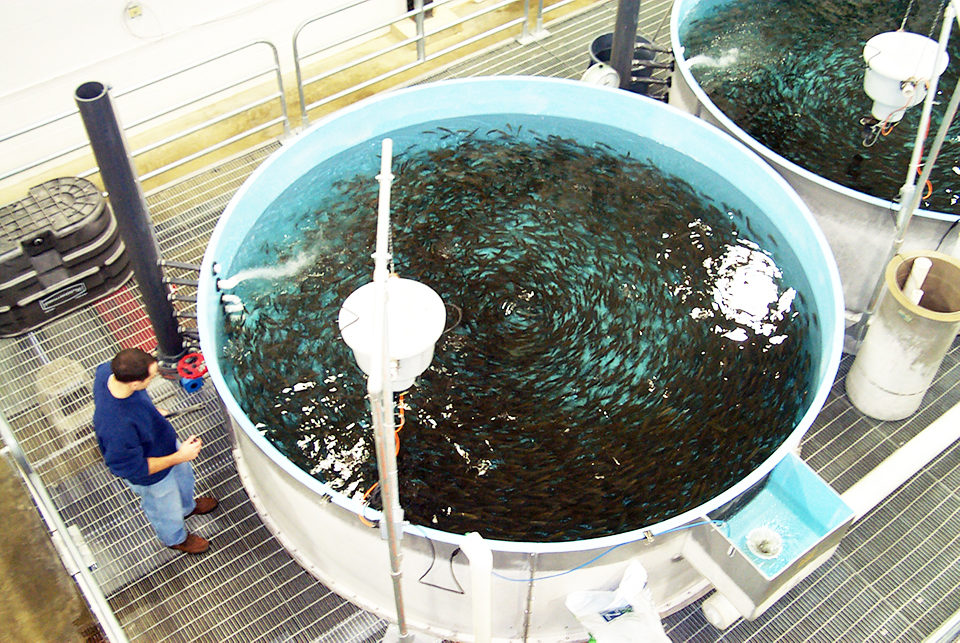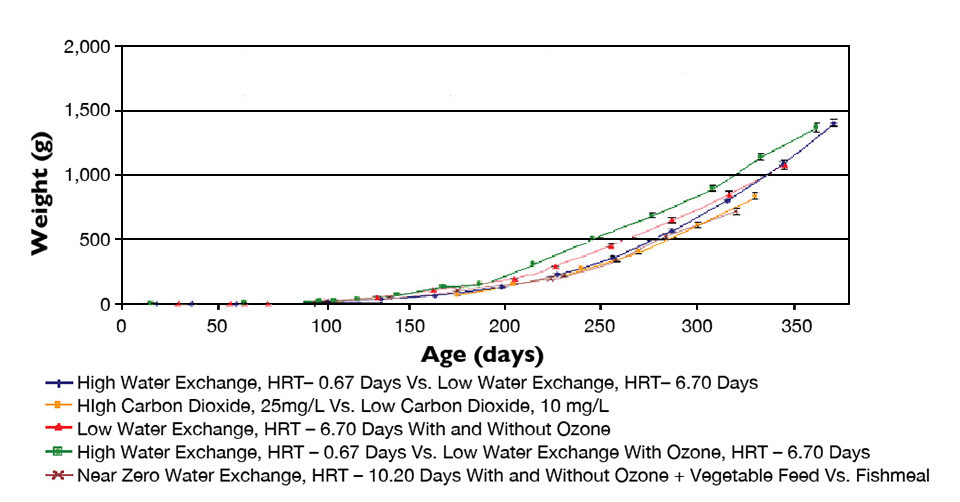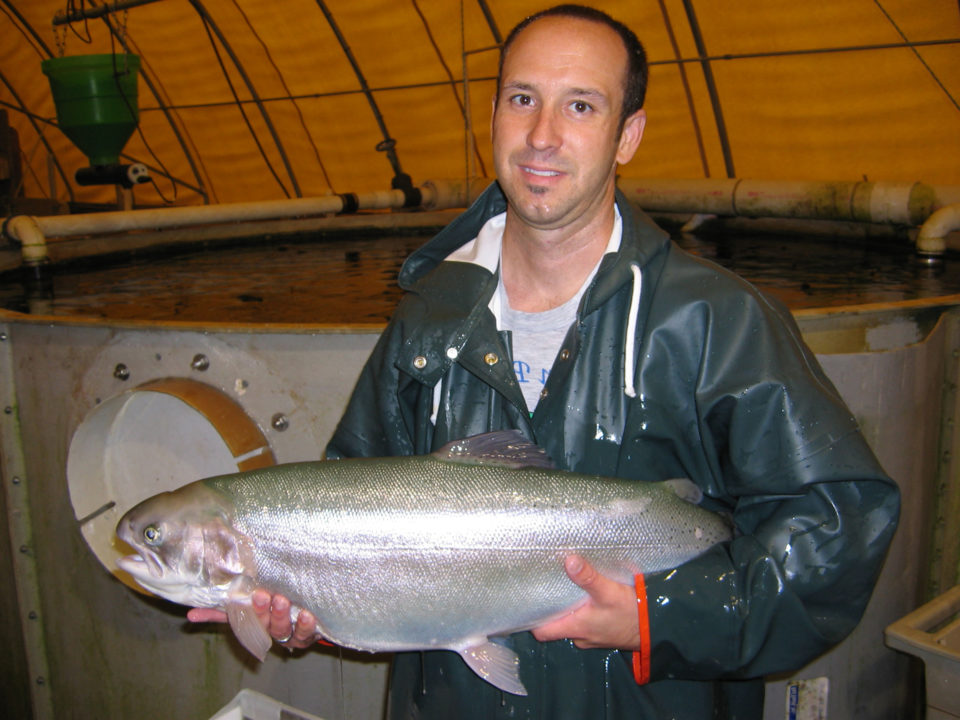Use of antibiotics, chemotherapeutants reduced

Land-based closed-containment production systems that use water recirculation can provide control of water quality and temperature to optimize fish production and health, prevent fish escapement and treat waste flows to curtail environmental impacts. They can also exclude and counter the effects of fish pathogens, reducing the need for chemical treatments within fish production systems.
Such systems can be located in regions where water resources are limited. In addition, locating recirculating systems near major urban markets greatly reduces the carbon emissions associated with product transportation.
RAS in Americas
In the Americas, recirculating aquaculture systems (RAS) are used by private and public facilities to produce rainbow trout, Arctic char and both Pacific and Atlantic salmon. These systems often include the following components: dual-drain circular culture tanks, radial-flow settlers to treat the tank bottom drain flow, microscreen drum filters, fluidized-sand biofilters, cascade aeration columns and low-head oxygenation units (Fig. 1).

These salmonid production systems are often operated with a make-up water supply that flushes the RAS volume completely on a daily basis. However, these systems also can be operated at much lower water-exchange rates when using ozone to maintain water quality and in applications where heat accumulation does not create temperature problems for the salmonids.
Rainbow trout
Rainbow trout have many attributes that make them an attractive species for farming. Domesticated strains of rainbow trout are commercially available as eyed eggs year- round and are relatively inexpensive compared to other salmonids. The availability of eggs can allow a farm to use continuous production strategies that help to maintain more culture tanks at near carrying capacity and allow fish production 52 weeks a year.
In addition, suppliers can provide eyed eggs that are certified free of listed pathogens. Therefore, if facility biosecurity protocols are effective, the use of antibiotics and chemotherapeutants associated with pathogen infections is reduced.
Years of research funded by the United States Department of Agriculture Agricultural Research Service at The Conservation Fund’s Freshwater Institute have found that rainbow trout grow particularly well in circular tank-based RAS. The institute typically achieves 900-g to 1.4-kg fish in 12 months post-hatch (Fig. 2).

RAS water quality
This growth was attributed to the quality of the germplasm being cultured and to the nearly ideal culture environment maintained in the culture systems. The conditions included water temperatures from 13 to 17 degrees-C, dissolved-oxygen concentrations maintained near saturation and dissolved carbon dioxide concentrations controlled at less than 25 mg/L.
Nitrite nitrogen concentrations are maintained at less than 0.3 mg/L, and total ammonia nitrogen concentrations are below 1.3 mg/L. Alkalinity is controlled at 150-200 mg/L. In addition, tank hydraulics produce a self-cleaning tank and optimal swimming speeds of 0.5-2.0 fish body lengths/second.
Ammonia is not usually a fish health concern in RAS systems, but mortality and reduced growth can be caused by nitrite accumulation, low dissolved-oxygen and high carbon dioxide concentrations, as well as elevated concentrations of fine suspended solids. However, at extremely low water-flushing rates, nitrate nitrogen and certain metals such as copper can accumulate to levels that create fish health issues.
Feeding
To maintain optimum water quality, the culture tank water is typically exchanged every 15 to 30 minutes, with the more rapid exchange applied in nursery systems that encounter high biomass densities with small fish that consume a high percentage of feed per unit body weight. The system also receives constant lighting and uses timer-controlled mechanical feeders that provide feeding every one to three hours.
The automatic feeding is supplemented with hand feeding to observe feed response and satiate the fish. A somewhat typical feeding chart is shown in Table 1, although observations of feeding activity and waste feed that indicate a short-term increase or decrease cause deviations from the schedule. This feeding schedule produces nearly constant water quality in the culture system, because it produces nearly constant biological respiration, oxygen demand and waste production rates.
Summerfelt, Approximate daily feeding rates, Table 1
| Age Range (Days from 50% hatch) | Size Range (g) | Percentage Body Weight/Day |
|---|---|---|
| 175-200 | 60-130 | 2.00 |
| 200-225 | 130-230 | 1.95 |
| 225-250 | 230-350 | 1.90 |
| 250-275 | 350-450 | 1.80 |
| 275-300 | 450-640 | 1.70 |
| 300-325 | 640-750 | 1.60 |
| 325-350 | 750-900 | 1.50 |
Since rainbow trout are aggressive feeders, the slow-sinking extruded feed pellets are distributed with flingers to reduce competition for food. A standard trout diet with 42 percent protein and 16 percent fat achieves feed-conversion rates of 1.0 or less for trout smaller than 100 g, 1.0 to 1.3 for 100-g to 1-kg trout, and 1.3 to 1.5 for larger fish. If desired, a higher-energy feed formulation can be used to improve feed conversion.
Biosecurity
Recirculating systems located within buildings that exclude disease vectors such as mammals and birds and are supplied with biosecure groundwater sources can operate using standard operating procedures to counter the effects of opportunistic fish pathogens.
Recirculating systems for rainbow trout at the Freshwater Institute have operated without the need for chemotherapeutants (other than salt) or antibiotics for almost 10 years. In that same time, pilot-scale and full-scale RAS experiments have produced over 200 metric tons of food-size rainbow trout and Arctic char.
The authors have observed RAS operated without adequate biosecurity measures that become dependent on regular treatments with chemotherapeutants like formalin to control pathogen proliferation while accepting persistently high morbidity and mortality in the affected fish populations.

Fish health
Flavobacteria – which are primarily associated with bacterial gill disease, but also columnaris and cold water disease – are the primary opportunistic fish pathogens encountered in rainbow trout cultured at the Freshwater Institute. However, flavobacteria have not created serious problems in the RAS when suspended solids concentrations were maintained below 10 mg/L or when dissolved-oxygen concentrations were maintained at approximate saturation within the culture tank.
Overall rainbow trout mortality is typically below 4 percent, and incidences of short-term increased mortality due to flavobacteria infections are countered by simply taking the fish off feed for a day and treating with 1 to 4 ppt of salt. Ironically, much more significant flavobacteria infections were encountered in rainbow trout cultured in the institute’s single-pass flow-through systems. Hydrogen peroxide treatment, salt therapy and extended feed withdrawal were necessary to counter these outbreaks, with comparatively much higher mortality than that observed in the RAS.
Fin erosion can be a more serious problem with rainbow trout than most other salmonids, which is another reason to thoroughly distribute feed and keep the fish well fed. Maintaining culture densities at or below 80 kg/m3 also helps reduce fin erosion, which in turn reduces the likelihood of morbidity and mortality associated with opportunistic infections. Reducing fin erosion also assists producers that provide trout for stocking purposes by increasing their product quality.
(Editor’s Note: This article was originally published in the March/April 2010 print edition of the Global Aquaculture Advocate.)
Authors
-
Steven T. Summerfelt, Ph.D.
The Conservation Fund’s Freshwater Institute
1098 Turner Road
Shepherdstown, West Virginia 25443 USA[103,114,111,46,101,116,117,116,105,116,115,110,105,114,101,116,97,119,104,115,101,114,102,64,116,108,101,102,114,101,109,109,117,115,46,115]
-
John Davidson
The Conservation Fund’s Freshwater Institute
1098 Turner Road
Shepherdstown, West Virginia 25443 USA -
Christopher Good
The Conservation Fund’s Freshwater Institute
1098 Turner Road
Shepherdstown, West Virginia 25443 USA -
Thomas Waldrop
The Conservation Fund’s Freshwater Institute
1098 Turner Road
Shepherdstown, West Virginia 25443 USA
Tagged With
Related Posts

Health & Welfare
Algae shows promise as alternative DHA source in rainbow trout diets
A growth trial in Canada evaluated the use of algae biomass to increase the concentration of long-chain polyunsaturated fatty acids in the tissues of rainbow trout.

Aquafeeds
Alternative lipids spare fish oil in rainbow trout feeds
Alternative lipids have achieved varied success in ensuring adequate growth and fatty acid composition in fillets. The authors evaluated rainbow trout raised on diets containing fish oil or a blend of fish and standard or modified lipids varying in fatty acid composition.

Intelligence
A land grab for salmon (and shrimp) in upstate New York
The operators of Hudson Valley Fish Farm see their inland locale as a pilot to prove that land-based fish farming, located in close proximity to major metropolitan markets, can be successful.

Aquafeeds
A look at corn distillers dried grains with solubles
Corn distillers dried grains with solubles are an economical source of energy, protein and digestible phosphorus to reduce feed costs and fishmeal usage.


